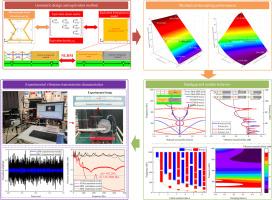低频波衰减的各向异性-各向同性杂化超材料
IF 9.4
1区 工程技术
Q1 ENGINEERING, MECHANICAL
International Journal of Mechanical Sciences
Pub Date : 2025-09-12
DOI:10.1016/j.ijmecsci.2025.110823
引用次数: 0
摘要
针对传统bragg散射材料中受晶格尺寸限制的低频带隙引发的挑战,我们提出了一种基于手风琴启发的零泊松比拓扑结构的创新单相机械超材料(AZM)。所提出的AZM架构独特地将各向异性和各向同性域集成在周期性单相系统中,通过协同波长调制和阻抗匹配效应在“亚波长”尺度上实现低频宽带布拉格散射带隙。理论分析表明,AZM单元格的正交机械解耦在主轴之间产生了25倍的模量对比,允许在保持结构刚度的同时减少低频振动。所开发的非局域均匀化方法揭示了其潜在机制:各向异性区域促进波长转换,而周期性阻抗界面增强布拉格散射,共同打开低频范围内的带隙。参数研究建立了清晰的结构-性能关系,表明带隙起始频率可以调到11 Hz (p波)和5 Hz (s波),同时在各种配置下保持宽带性能。实验验证证实了卓越的性能,三周期AZM实现了75%的波衰减,具有显著的相对带宽。这项工作建立了低频Bragg带隙机制的突破性框架,开创了一种新的设计范式,从根本上推进了Bragg超材料用于低频宽带振动控制的理论认识和实践实现。本文章由计算机程序翻译,如有差异,请以英文原文为准。

Anisotropic-isotropic hybrid metamaterials for low-frequency wave attenuation
Addressing the challenge of low-frequency bandgap initiation in conventional Bragg-scattering metamaterials constrained by lattice size limitations, we present an innovative single-phase mechanical metamaterial (AZM) based on an accordion-inspired zero Poisson's ratio topological configuration. The proposed AZM architecture uniquely integrates anisotropic and isotropic domains within a periodic single-phase system, enabling low-frequency broadband Bragg-scattering bandgap at ‘subwavelength’ scales through synergistic wavelength modulation and impedance matching effects. Theoretical analysis demonstrates that the AZM unit-cell's orthogonal mechanical decoupling creates a 25-fold modulus contrast between principal axes, permitting low-frequency vibration reduction while preserving structural stiffness. The developed non-locality homogenization method reveals the underlying mechanism: anisotropic regions facilitate wavelength conversion while periodic impedance interfaces enhance Bragg-scattering, collectively opening the bandgap in the low-frequency range. Parametric studies establish clear structure-property relationships, showing bandgap initiation frequencies can be tuned to 11 Hz (P-wave) and 5 Hz (S-wave) while maintaining broadband performance across various configurations. Experimental validation confirms exceptional performance, with three-periods AZM achieving >75 % wave attenuation, featuring remarkable relative bandwidth. This work establishes a groundbreaking framework for low-frequency Bragg bandgap mechanism and pioneers a novel design paradigm, fundamentally advancing both the theoretical understanding and practical realization of Bragg metamaterials for low-frequency broadband vibration control.
求助全文
通过发布文献求助,成功后即可免费获取论文全文。
去求助
来源期刊

International Journal of Mechanical Sciences
工程技术-工程:机械
CiteScore
12.80
自引率
17.80%
发文量
769
审稿时长
19 days
期刊介绍:
The International Journal of Mechanical Sciences (IJMS) serves as a global platform for the publication and dissemination of original research that contributes to a deeper scientific understanding of the fundamental disciplines within mechanical, civil, and material engineering.
The primary focus of IJMS is to showcase innovative and ground-breaking work that utilizes analytical and computational modeling techniques, such as Finite Element Method (FEM), Boundary Element Method (BEM), and mesh-free methods, among others. These modeling methods are applied to diverse fields including rigid-body mechanics (e.g., dynamics, vibration, stability), structural mechanics, metal forming, advanced materials (e.g., metals, composites, cellular, smart) behavior and applications, impact mechanics, strain localization, and other nonlinear effects (e.g., large deflections, plasticity, fracture).
Additionally, IJMS covers the realms of fluid mechanics (both external and internal flows), tribology, thermodynamics, and materials processing. These subjects collectively form the core of the journal's content.
In summary, IJMS provides a prestigious platform for researchers to present their original contributions, shedding light on analytical and computational modeling methods in various areas of mechanical engineering, as well as exploring the behavior and application of advanced materials, fluid mechanics, thermodynamics, and materials processing.
 求助内容:
求助内容: 应助结果提醒方式:
应助结果提醒方式:


